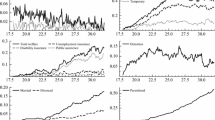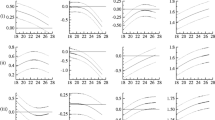Abstract
This study examines the relationships between the employability and criminality of white and black male teenagers. A disequilibrium model of employment and crime is formulated and estimated as a simultaneous probit equation system. Our results show that black teenagers who are employed engage in fewer criminal activities. Thus, it appears that blacks view employment and crime as alternative income-generating activities. On the other hand, the criminal behavior of white male teenagers is unaffected by their employment status. The evidence that we provide indicates that whites tend to use employment as a cover for crime or to moonlight in crime. The differences in the behaviors of whites and blacks can be explained, in part, by different legitimate opportunity structures for whites and blacks. One of the more important policy implications is that job opportunities targeted to high risk, black teenage populations will have the additional beneficial effect of reducing crime rates.
Similar content being viewed by others
Notes
U.S. Bureau of Labor Statistics,Handbook of Labor Statistics (Bulletin 2217, U.S. Government Priming Office, Washington, D.C., 1985).
See Kim B. Clark and Lawrence Summers, “The Dynamics of Youth Unemployment” inThe Youth Labor Market Problem: Its Nature, Causes, and Consequences, Richard B. Freeman and David Wise, editors, (Chicago: University of Chicago Press, 1986). Also Peter Jackson and Edward Montgomery. “Layoffs, Discharges and Youth Unemployment,” inThe Black Youth Employment Crisis, Richard B. Freeman and Harry J. Holzer, editors. (Chicago: The University of Chicago Press, 1986).
Mercer L. Sullivan,New York Affairs (NYU Urban Research Center, N.Y., New York, 1983); Michelle Sviridoff and James L. Thompson, “Links Between Employment and Crime: A Qualitative Study of Rikers Island Releases,”Crime and Delinquency 29 (April 1983), pp. 195–212.
David T. Ellwood, “The Spatial Mismatch Hypotheses: Are There Teenage Jobs Missing in the Ghetto?” inThe Black Youth Employment Crisis, Richard B. Freeman and Harry J. Holzer, editors. (Chicago: The University of Chicago Press, 1986).
Timothy J. Flanagan and Edmund F. McGarrell,Sourcebook of Criminal Justice Statistics (U.S. Government Printing Office, Washington, D.C., 1985), pp. 484.
Alfred Blumstein, “The Impact of Changes in Sentencing Policy on Prison Populations,” inResearch on Sentencing, Alfred Blumstein ed. (Washington, D.C.: National Academy Press, 1983), pp. 460–489.
Dall Dannefer and R.D. Schutt, “Race and Juvenile Processing in Court and Police Agencies,”American Journal of Sociology Vol. 87, No. 5 (1982), pp. 1113–32; G. Kleck, “Racial Discrimination in Criminal Sentencing: A Critical Evaluation of the Evidence with Additional Evidence on the Death Penalty.”American Sociological Renew 46 (December 1981), pp. 783–805; M. Farnworth and P.M. Horan, “Separate Justice: An Analysis of Race Differences in Court Processes,”Social Science Research 9 (1980), pp. 381-99; M.J. Hindelang, “Race and Involvement in Common Law Personal Crimes,”American Sociological Review 43 (1978), pp. 93–109.
S. Kepper, D. Nagin and L. Tierney,Research on Sentencing (National Academy Press, Washington, D.C., 1983); John Hagan and Marjorie S. Zatz, “Crime, Time and Punishment: An Exploration of Selection Bias in Sentencing Research,”Journal of Quantitative Criminology Vol. 1, No. 1, (1985), pp. 103-26.
David H. Good and Maureen A. Pirog-Good, “Employment, Crime and Race,”Contemporary Policy Issues Vol. 5, (July 1987), pp. 91–104. David H. Good, Maureen A. Pirog-Good and Robin C. Sickles, “An Analysis of Youth Crime and Employment Patterns, 1986,”Journal of Quantitative Criminology 2 (September 1986), pp. 219–236.
Gary Becker, “Crime and Punishment: An Economic Approach,”Journal of Political Economy 76 (March–April 1968), pp. 169–217.
D. Bogen, “Juvenile Delinquency and Economic Trends, 1944,”American Sociological Review 9 (April 1944), pp. 178–84; Llad Phillips, Donald Maxwell and Harold Votey, “Crime, Youth and the Labor Market,”Journal of Political Economy 80 (June 1972), pp. 491–504; Daniel Glaser and Kent Rice, “Crime, Age, and Unemployment,”American Sociological Review 24 (October 1959), pp. 679-86; Belton Fleisher,The Economics of Delinquency (Chicago: Quadrangle Books, 1966); Belton Fleisher, “The Effect of Income on Delinquency,”American Economic Review 56 (March 1966), pp. 118-37; Larry D. Singell, “An Examination of the Empirical Relationship Between Unemployment and Juvenile Delinquency,”The American Journal of Economics and Sociology 26 (October 1967), pp. 377-86; John C. Weicher, “The Effect of Income on Delinquency: Comment,”American Economic Review Vol. 61, No. 1 (1970), pp. 249-56.
Peter Schmidt and Anne Witte,An Economic Analysis of Crime and Justice (New York: Academic Press, Inc., 1984); Richard B. Freeman, “Crime and Unemployment,” inCrime and Public Policy, James Q. Wilson, ed., (California: ICS Press, San Francisco, California, 1983), pp. 89–106.
David Cantor and Kenneth C. Land, “Unemployment and Crime Rates in the Post-World War II United States: A Theoretical and Empirical Analysis,”American Sociological Review 50 (June 1985), pp. 317–32; Michael Massourakis, Farahmond Rezvani and Todashi Yamada, “Occupation, Race, Unemployment and Crime in a Dynamic System,” National Bureau of Economic Research Working Paper No. 1256, 1984, 17 pp.
R.L. Christenson and Terence P. Thornberry, “Unemployment and Criminal Involvement: An Investigation of Reciprocal Causal Structures,”American Sociological Review 49 (June 1984), pp. 398–411; Schmidt, op. cit.; Samuel L. Myers, “Race Differences in Post-Prison Employment,”Social Science Quarterly 64 (September 1983) pp. 655-69; Anne Witte, “Estimating the Economic Model of Crime with Individual Level Data,”Quarterly Journal of Economics 94 (February 1980), pp. 57–84.
Maureen A. Pirog-Good, “Modeling Employment and Crime Relationships,”Social Science Quarterly 67 (December 1986), pp. 767–784; Samuel L. Myers, “Employment and Crime: An Issue of Race?,”The Urban League Review 6, (Fall 1981), pp. 9–24; Witte, op. cit.
op. cit..
op. cit. ; Sviridoff, et al., op. cit.; Harold Holtzman, “The Serious Habitual Property Offender as ‘Moonlighter’: An Empirical Study of Labor Force Participation Among Robbers and Burglars,”Journal of Criminal Law and Criminology 73 (1983), pp. 1774-92; Myers, 1983, op. cit.
op. cit..; Christenson and Thornberry, op. cit.
op. cit..
Mercer L. Sullivan,New York Affairs (New York: NYU Urban Research Center, N.Y., New York, 1983).
Peter Jackson and Edward Montogomery, “Layoffs, Discharges and Youth Unemployment,”The Youth Labor Market Problem: In Its Nature, Causes, and Consequences, (Chicago: University of Chicago Press, 1986).
op. cit..
op. cit. ; Isaac Ehrlich, “Participation in Illegitimate Activities: A Theoretical and Empirical Investigation,”Journal of Political Economy 81 (May–June 1973), pp. 521-65.
Good and Pirog-Good, 1987, op. cit.; Good, et al., 1986, op. cit.
op. cit..
T. Amemiya, “The Estimation of Simultaneous Equation Generalized Probit Models,”Econometrica 46 (1978), pp. 193–205; J. Heckman, “Dummy Endogenous Variables in a Simultaneous Equation System,”Econometrica 46 (1978), pp. 931–959.
For more detailed information on econometrics of this model, see Good, et al., 1986, op. cit.
See, Llad Philips and Harold J. Votey, “Rational Choice Models of Crime by Youth” in this volume.
op. cit..
op. cit..
David Cantor and Kenneth C. Land, “Unemployment and Crime Rates in the Post-World War II United States: A Theoretical and Empirical Analysis,”American Sociological Review 50 (June 1985), pp. 317–32.
About this article
Cite this article
Good, D.H., Pirog-Good, M.A. A simultaneous probit model of crime and employment for black and white teenage males. Rev Black Polit Econ 16, 109–127 (1987). https://doi.org/10.1007/BF02900927
Issue Date:
DOI: https://doi.org/10.1007/BF02900927




